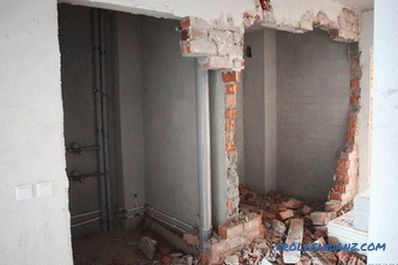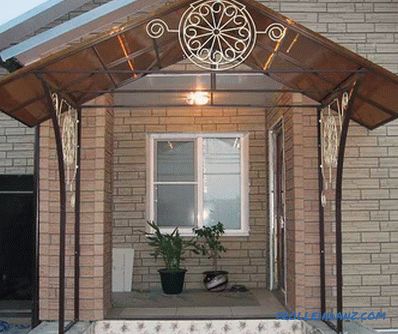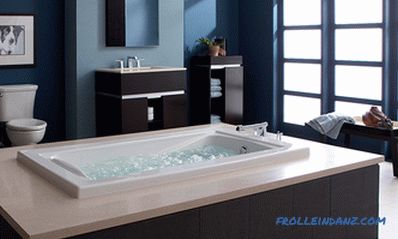It would seem that such a simple task as choosing an oven is actually much more difficult than it seems at first glance. Selection of a suitable model is carried out in many ways, some of which must be taken into account, and some may not be useful. In this case, you first need to decide on the necessary functionality, and then compare the device models, their characteristics and price.
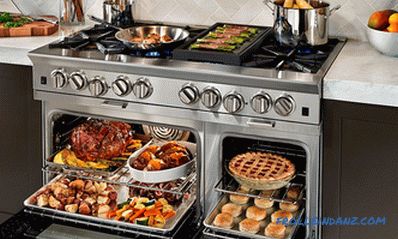
Heating Method — Gas or Electricity
This is the first and main choice to be made. Mainly, which oven to choose depends on where it will be used, as well as the price of gas and electricity in a particular region. That is, you need to know what features and communications your room has. Additionally, one must take into account the functionality of the devices - electric ovens in this regard are significantly ahead of the devices working on gas. It also happens that you just do not want to relearn, because the hand is already "full" to work with a certain type of devices.
Features of gas ovens
Gas ovens can operate on both natural and liquefied gas.

Most often they have only one burner, which is located at the bottom. Some models have a grill in the upper part, but very few of them. This detail complicates the design and requires additional thermal insulation - the gas from the grill nozzles does not go down, but to the sides and up, giving almost half of the heat to the oven body.
There is no automatic temperature control for such devices - you need to get used to each oven separately. If you often have to cook dishes that require keeping a certain temperature, then you will have to buy a thermometer for the gas oven. For the same reason, such devices are rather poor in functionality — automation simply cannot carry out precise manipulations with mechanical regulators of the gas supply.
Also, with frequent use, it is desirable to bring a good exhaust hood to the oven - when operating the stove, carbon monoxide will accumulate in the air, which can cause headaches.
The main advantages of gas ovens are that they are economical to use and that they can be used in places where there is no electricity - this is an ideal option for giving where you can connect a gas cylinder and cook.
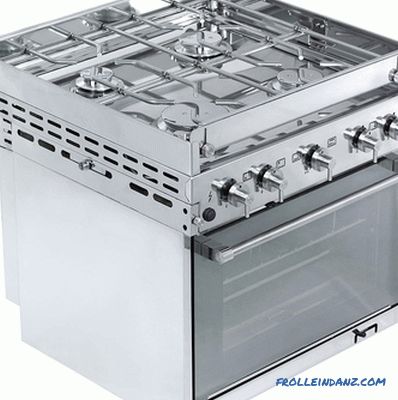
Electric ovens
In addition to the relative high cost of operation and the impossibility of autonomous use, these devices have no disadvantages. Heating elements can be located above, below and on the side, which allows to warm up cooked dishes evenly. Maintaining the desired temperature occurs by turning on and off the heating elements, which is freely implemented even in budget models. The absence of an open flame means better fire safety and advanced functionality including, for example, convection heating, which is rather difficult to implement in gas ovens.
The most functional models are equipped with a steam generator and a magnetron, which allows you to combine the oven, steamer and microwave in one case.
Considering that in the average family they use the oven two, on the strength of three times a week, the cost of electricity is unlikely to grow significantly. Coupled with wide possibilities and usability, this makes electric ovens the undisputed market leader, gradually replacing gas models.
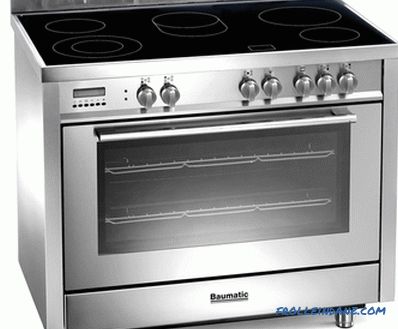
Built-in or freestanding
All ovens can be divided into recessed, which are installed inside kitchen cabinets and stand-alone. Which of them to purchase depends on the availability of free space and kitchen furniture into which the oven is built. It should also be borne in mind that the free-standing ovens are located mainly on the floor, and the built-in ovens can be raised to the required height.
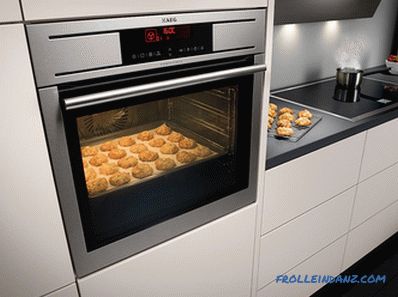
Not only electric, but also gas models can be built in.
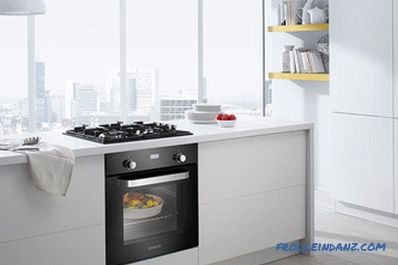
For the rest, there are no significant differences, but in any case, it should be understood that the oven is very hot during operation. Separate models should be placed at least 10 cm from the wall, and for embedded ones, good ventilation should be provided. Ignoring these simple requirements will, at best, lead to detachment of the kitchen furniture cover, and at worst to a fire.
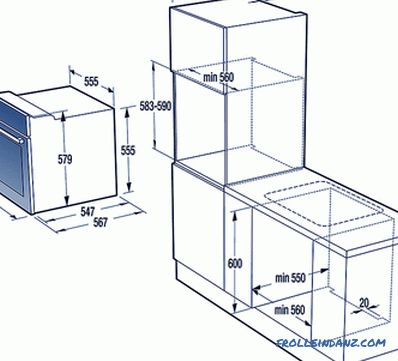
Rules for embedding the oven.
Dependent and independent ovens
Dependent refers to those ovens that are produced in tandem with the cooking surface.
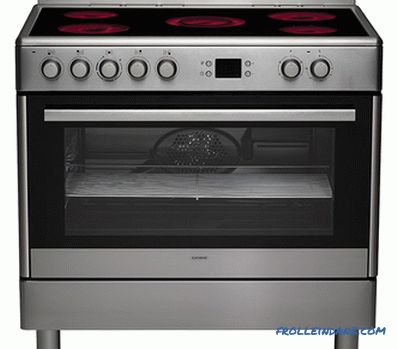
Independent are only an oven without additional modules.
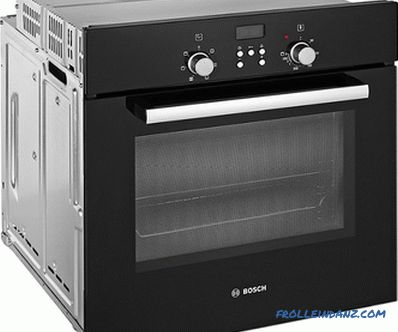
Mainly, the choice of this parameter comes down to design and ease of management. The fact is that the dependent devices are either sold together with the hob or they can be selected from the products of the same manufacturer.Independent, in turn, are always installed separately and have their own controls.
The main advantage of dependent ovens is the cost - it is always cheaper to purchase a kit than two devices separately. The disadvantage in some cases is just the general control panel: if it fails, both devices will stop working. In addition, the control unit dependent devices significantly more than the individual. Also dependent oven and hob must necessarily be located next door.
Accordingly, the advantage of independent ovens lies in the greater freedom of location and the possibility to choose a cooker for them from any manufacturer, which is sometimes even preferable in terms of kitchen design.
Heating modes of gas and electric ovens
Here, there is a clear advantage for electric ovens. If gas can only have heating from below, and in models with a grill from below and from above, then electric besides warming up dishes from all sides allow using the following modes:
Defrosting - produced at room temperature. Tena do not work, and blowing frozen food is carried out by a fan.
Fast defrosting - one of the heating elements is working at minimum power, and the fan inflates the warm air inside the chamber. In the gas oven, this mode is impossible, since a weak fire will simply blow out by the air flow created by the fan.
Standard mode - depending on the program, the heaters are operated together or separately.
Accelerated (convection) mode - except for heaters, a fan is used. The heating elements heat the products by means of radiation, and the fan drives hot air through the chamber.
Fast cooking mode at different levels - all PETs and fans are included, and the prepared dishes are located on different baking sheets.
Browning - only the upper heater is included. A useful feature for those cases when the dish is ready, but not enough crust, which gives it such an appetizing look.
Grill - standard or with additional air circulation around the dish, which allows for a more uniform heating of its surface and get a crisp from all sides.
When deciding how to choose a good oven, it is recommended to pay attention to the presence of these modes, but whether they will be in demand is up to you.
Culinary functionality - that gas and electric ovens are able to
The main task of any oven is to create and maintain a certain temperature inside, necessary for cooking. When they “learned” how to cope with this task perfectly well, manufacturers began to add additional functions to the ovens that speed up, simplify and improve the cooking process. Most of them are realized only in electric ovens, but there are useful trifles in gas devices.
Functions of gas ovens
The mechanical way of adjusting the flame does not allow creating any significant automation of cooking in gas ovens, so you don’t have to think about automatic cooking programs - everything is set manually and requires constant attention .
The required temperature is set in the oven "by eye", and if accuracy is required, then you will have to buy an additional thermometer for ovens, although if the model is not budgetary, then it is usually equipped with it initially. At the same time, the temperature is set by the test method - the stove first gets warm, and if the fire is set incorrectly, then it is diminished or added.
A bit more functionality is available for models with a grill, which allows you to additionally warm up the dish from above.
But when choosing such an oven, it is necessary to take into account whether it is gas or electric - if you intend to use the oven in a country house where there is no electricity, in the second case this function will remain unclaimed.
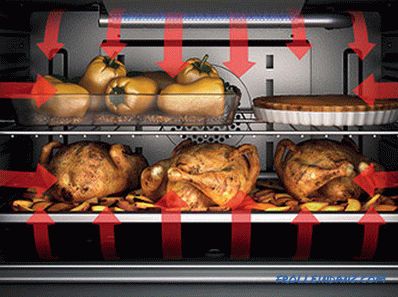
Additionally, gas ovens can also warm up a cooked dish in a convective way. This is achieved by placing it inside the case of the fan, which will blow hot on the cooking dish. It should be borne in mind that models equipped with such a device are more expensive to manufacture - they need to make special burners whose flame is protected from drafts, and also to equip the stove with additional protection that either turns on the flame in case of its extinction or completely blocks the gas supply.
Functions of electric ovens
Due to the absence of an open flame that can be extinguished from the draft, and the availability of electronic control, the electric ovens in terms of culinary functionality give a big handy to their gas counterparts.
The first advantage is the ability to automate the cooking process, since the electric heating elements can be turned on and off according to a predetermined program. This allows us not only to turn the oven on or off at the right time, but also to memorize entire recipes designed not only for different dishes, but also for different types of meat and fish.
The same property is used to set and maintain the desired temperature - a special sensor turns off the power when the air inside the furnace warms up and turns it on when it cools down.
Since the upper and lower heating elements are often equivalent in power, this allows you to cook at least two dishes at the same time, placing them in the chamber at different levels. If only the top heater is turned on, the dish itself is not baked from the inside, and an appetizing crust is fried from above.
The absence of an open flame provides more opportunities for using convection heating in electric ovens. This is realized with the help of one or several fans, which will blow hot air over the preparing dish and ensure its uniform heating.
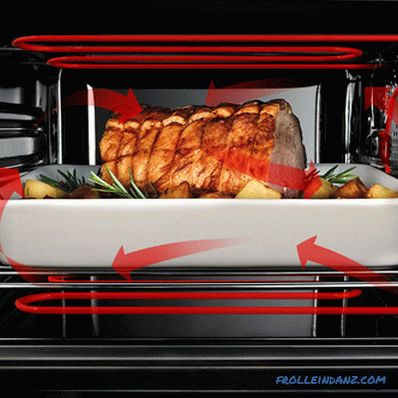
There are models with two independent convectors that allow you to cook two different dishes at the same time, at different levels without mixing their smells.
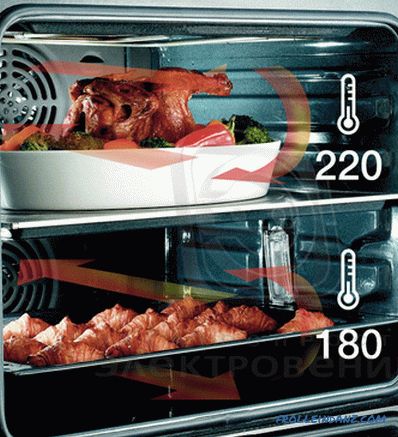
The design of the oven allows you to easily equip it with a magnetron, which allows you to add to the list of functions microwave mode, when the cooked food warms up from the inside.
In the "elite" class devices, special attention is paid to the methods of cooking with the preservation in it of the maximum amount of useful substances. Such models are equipped with a steam generator and an additional container for water - when you turn on the appropriate mode, the oven is used as a double boiler.
Components for expanding the functionality separately if necessary and possible to install.
Spit . They can be equipped with both electric and gas oven. An indispensable thing for lovers of kebabs and barbecue - allows you to evenly bake on all sides, even large pieces of meat or a whole chicken (depending on the size of the oven). It is possible to refuse a spit if the stove is equipped with a convective heating function - the result of using both methods is approximately the same.
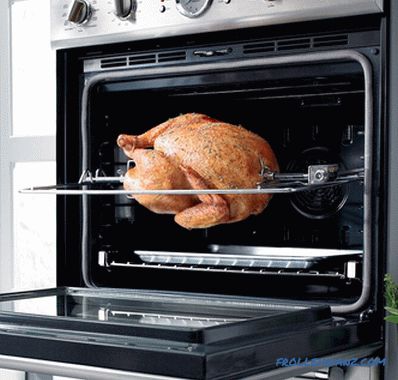
Thermal probe . The original way to control the temperature at which the cooking takes place. The temperature sensor measures the degree of heating not the air in the oven, but the cooking dish itself. It is placed in a thin rod of stainless steel, which is pierced, for example, preparing meat. Thermal probe can be built into the oven initially, and then it is in fact just another sensor from which data is read. It uses a wired and wireless connection method, and the information received is displayed. Also, the probe can be purchased separately, and not necessarily tied to one manufacturer, but in this case, you can not guarantee full compatibility with the selected model of the furnace.
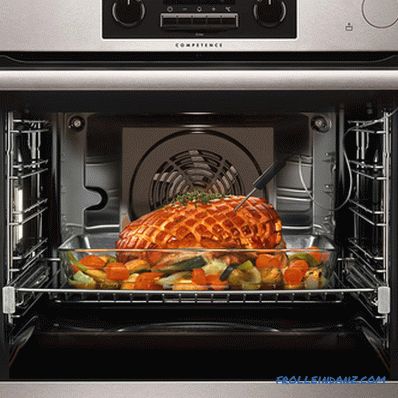
Separate thermometers . Not all cabinets, especially low-end gas, can show the temperature inside the heating chamber, therefore, paired with them use mechanical thermometers, which are purchased separately (or come as a bonus from the store). They show the temperature by expanding the spring on which the arrow is fixed, which displays on the scale the heating level of the oven. The only inconvenience of their use is that you first have to pull the thermometer out of the oven, and then get the dish itself.
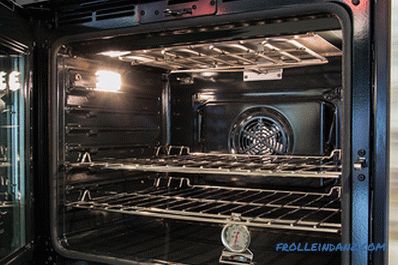
The built-in alarm clock is good when it’s with a loud and nasty sound. If in furnaces with an electronic control type, in addition to the timer, there may also be sensors that react to the smell of burning and turn off the oven, then devices with a gas-type heating system cannot boast such. If you forget about the cooking dish and do not hear the alarm, then the prospect of ordering pizza from the restaurant increases with every second.
Methods for cleaning ovens
When deciding how to choose an oven, special attention should be paid to possible methods of keeping it clean, because even with the most careful handling, each oven periodically needs to be cleaned. In the future, to spend on this process as little time as possible, it is worth considering in advance what methods it will be cleaned of dirt and grease:
The traditional way is washing water remedy, sponge, and a lot of patience. It is used for gas and electric ovens.
Hydrolysis cleaning - in general, the same traditional cleaning method, but initially a baking tray with water is put in the oven, which turns into steam and softens all accumulated on the oven walls mud. Some of it may even drain on a baking sheet, but the rest will be much easier to clean. The steam burners are not terrible for gas burners, electric heating elements are airtight, so the method can be used in both types of furnaces. It is advisable to let the devices dry well after the procedure.
The pyrolysis method is simple enough by itself, but its use is allowed only if the oven, gas or electric, has the appropriate material for the walls of the chamber. It consists in burning the empty chamber to such a temperature, when the dirt simply burns off by itself. When the oven cools down to about 50-60 degrees, then it remains to walk along the walls with a damp rag.
The catalytic method is somewhat similar to the previous one, but heating is performed at lower temperatures. This is possible in ovens of any type, the walls of which are covered with special enamel containing a catalyst - when heated, it is released and splits the grease accumulated on the surface. Preparation usually takes place at temperatures of 180-250 degrees, and the catalyst is released when heated from 300, so it is guaranteed that it will not get into the food. Under the action of the catalyst fat becomes friable and is easily erased with a sponge. The only disadvantage of the method is that the catalyst is exhaled after 5-8 years of operation of the stove, but the panels with enamel can be replaced.
Oven Door
There are three types of oven doors, depending on the opening mechanism. The door can be folding, hinged and sliding.
A hinged door is the most common option, but it is not always convenient, especially in small kitchens. On the other hand, this door allows you to put a baking sheet on it before placing it in the oven or immediately after removing it, sometimes it is very convenient.
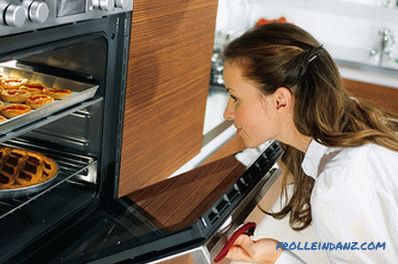
The hinged door opens to the right or left. It is convenient in the case when the oven is not installed on the floor, but is built into the cupboard at chest level.
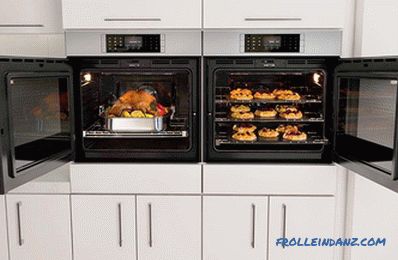
The sliding door assumes such a design in which the trays are fixed on it and move forward with it. When using such a system, you do not have to put your hands in the hot inside of the oven.
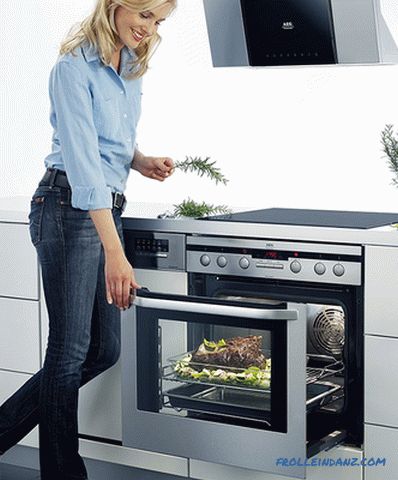
Most oven doors have double glazing. But there are models with three or even four glasses. The more glass at the door, the better thermal insulation the oven has. This affects both the cooking time and safety, since the risk of injury is reduced. Therefore, the rule here is that the more, the better.
Choice of control system
All gas ovens are mechanically regulated - on the control panel there are knobs and switches that control the gas supply and the activation of the necessary modes.
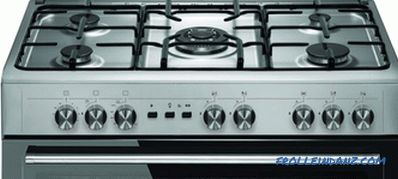
Electric ovens, depending on the cost of the model, are controlled by electromechanical or electronic means. In the first case, these are several rotary controls that are not mechanically connected with anything, but only close the contacts controlling the activation of the modes. One of the regulators sets the working temperature, the second - the heating mode, the third is the timer, which either turns off the power to the oven or beeps when the cooking is finished. Depending on the functionality of the regulators may be more, but these three will be present in any case.
Fully electronic control is implemented on buttons or sensors. Next to them is always the display, which displays all the information about the included program, and also displays information from the sensors. TOP models are equipped with a touch screen, to which information is displayed just like on a smartphone or tablet - if the display is small, this is not a sign of a small number of functions - information on the screen can be scrolled like a menu in the same smartphone.
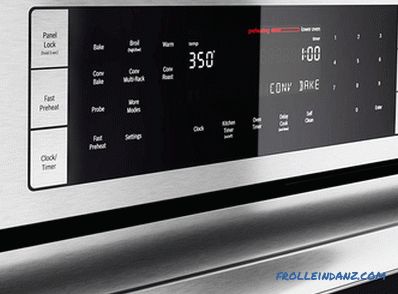
Often, combined control is set up in furnaces, when all the exact functions are set by the sensor, and the main ones by the mechanical regulators.
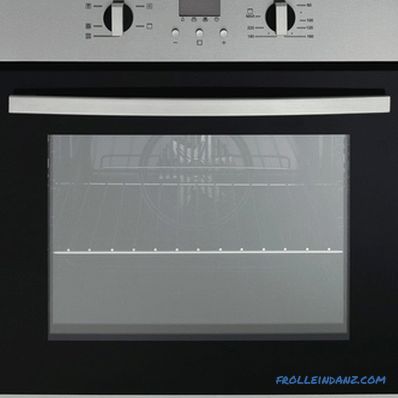
The electromechanical type of control is considered to be the most reliable - in fact, there is nothing to break in it, unlike touch screens, which have a small margin of safety, plus a greater chance of getting out of building when exposed to temperatures above 70 degrees.
Oven dimensions and usable volume
In external dimensions, ovens are conventionally standard, compact or narrow.
Standard full-size ovens are made 60-90 cm wide, about 60 cm high and 50-55 cm deep. At the same time, the useful volume is in the range of 55-68 liters, which is more than enough to prepare meals for a large family.
Compact devices differ from full-size ones in smaller height - about 45 cm, and narrow ones have the same size in width. The volume of such ovens up to 45 liters.

These are not all sizes, for example, there are mini-ovens for 5–15 liters of usable volume. In any case, the purchase must be guided by the availability of free space in the kitchen, and choose a place for the stove, so that it has free access, and its doors open freely.
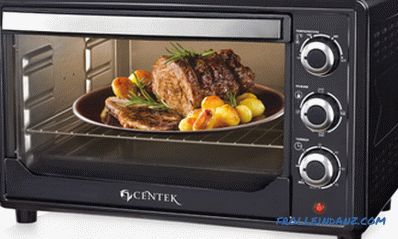
Baking sheets and equipment
The number and size of the trays that come with the stove are not standard - each manufacturer can complete them in their own way. This point is necessary to specify when buying, in case of need to purchase the desired baking sheet. The presence of at least two solid baking trays (of the same or different depth) and baking tray is considered mandatory.
Some manufacturers offer enamel trays directly out of the box, either with a coating that provides a non-stick effect or prevents metal from deforming when exposed to high temperatures. Sometimes the package also includes a glass baking sheet - this can be a bonus when buying an elite model of the oven.
In modern ovens, there is at least one set of telescopic rails. They prevent the baking sheet from turning over when it is removed from the oven, and some models also protect the back wall of the oven from shocks during loading. It is also just convenient - the baking sheet moves much easier on the "telescopes" than on the standard guides. When choosing a stove it is strongly recommended to pay attention to this accessory and its quantity. It can be one, rearranged to any level or separate for all guides at once. If there are no “telescopes” or they are few, then it is necessary to clarify the possibility of their acquisition and installation separately.
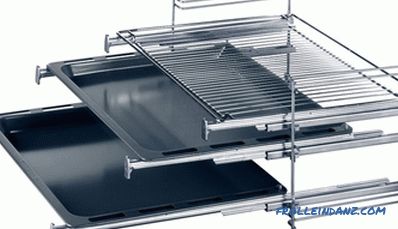
Telescopic rails.
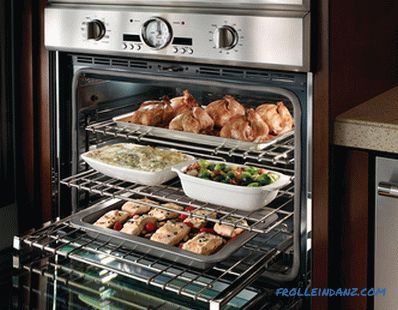
Telescopic guides mounted in the oven.
Security systems
Since the oven is an elevated temperature zone, in order to choose the right oven, it is necessary to pay attention not only to the quality of cooking, but also to the presence of various protective devices in the device. Especially this question is relevant if the family has small children.
Cooling system
Since the oven is often embedded in furniture, it is very important that its outer walls remain at an acceptable temperature. For this purpose, an exhaust hood is supplied to it, and in the places of contact with furniture, sensors are installed that turn off the device when a dangerous temperature occurs on the walls. Also important is the burn warning system that controls the temperature of the oven door. There are no big tricks here - just it uses from two to four glasses, the space between which a separate fan blows cold air, which usually comes from under the bottom of the cabinet.
Lighting
It would seem that this function is far from safety issues, but given that furnaces equipped with high-quality lighting do not have to be opened and closed once again, it significantly reduces the chance of getting burned, especially if the stove is budget and not equipped with a door cooling system.
Locks
Their number and purpose differ depending on the type of oven. A gas device necessarily has a gas control system that closes the supply valve when the flame is attenuated. In the ovens with electronic touch controls, it is imperative to lock the screen from accidental clicks, preventing the child from changing the program. If a catalytic cleaning method is used in the device, then the oven doors should be blocked from accidental opening during its operation. The same protection can be installed during normal operation.
Oven manufacturers
Definitely, choosing the best manufacturer will not work, as there are leaders in the production of certain types of equipment or in a separate price category. If you buy an oven of the middle or upper price segment, it is recommended to pay attention not even to the manufacturer, but to the presence of its service centers in the region.
The most famous trademarks most often found in stores:
Gorenje .

It is deservedly one of the market leaders and offers products in the middle and high price segment, with appropriate quality and functionality.
Siemens .

A German trademark, one of the trendsetters in the industry, constantly updating its products with the advanced functionality of its own developments. User reviews describe this technique as reliable and durable.
Ariston .

Specializes in middle-class products, offering customers functional devices at affordable prices. Also in the lines there are budget and TOP models, but their choice is not too wide.
Bosch .

One of the oldest companies in the market specializing in gas and electric ovens. In addition to the reliability of functionality and visual appeal, its products are distinguished by democratic prices, since their own developments are used in production.
Gefest .

The Belarusian trademark, which initially occupied the niche of inexpensive and high-quality electric and gas ovens.
Zanussi .

The Italian manufacturer develops product lines for all price categories, offering customers devices of various functionality, of consistently high quality.
Candy .

The company specializes in the production of budget ovens, which, with quality and cost, give odds to the closest competitors.
Miele .

The brand name is little known to a wide range of customers - the company focuses exclusively on elite-class products, with corresponding quality and price. In addition to reliability and functionality, much attention is paid to how the ovens fit into the interior of the kitchen.
Electrolux .

One of the pioneers of the industry, without exaggeration, who knows everything about ovens. In production, it launches exclusively its developments, independently producing each of the components.
Smeg .

Another representative of a few oven manufacturers, focused on customers with high demands, ready to pay the appropriate money for quality and exclusive.
These are not all well-known manufacturers - while choosing, you can look closely at such brands as Hansa, Beko, Indesit, Kuppersberg, Fornelli, Maunfeld, Ardesia, Hotpoint-Ariston and others that are not got into this list, but let out ovens of worthy quality.
Video. How to choose the oven
